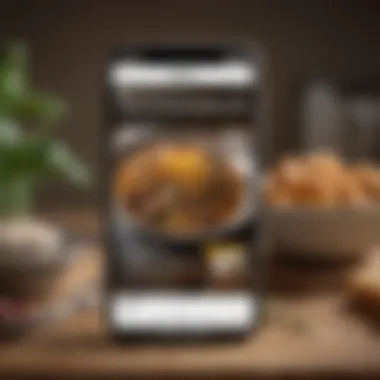Maximizing Culinary Efficiency with Ingredient Apps


Intro
In a world running at breakneck speed, finding time to create sumptuous meals can feel like chasing shadows. Many busy professionals and families often resort to takeout or pre-packaged meals that lack the personal touch of home-cooked cuisine. This is where ingredient-based recipe applications step in, serving as a lifebuoy for those drowning in deadlines and the relentless pace of life. These savvy tools allow users to input what they have in their pantry and transform mere ingredients into delightful dishes that cater to one’s palate and dietary preferences.
Imagine you have some leftover chicken, a handful of vegetables, and a few spices lurking at the back of your fridge. Instead of letting those ingredients languish away, an ingredient-based recipe app can suggest a delightful stir-fry or bake that will satisfy both hunger and taste buds.
This article takes a closer look at the functionalities and benefits of these innovative apps, unraveling their potential to enhance culinary efficiency. We will highlight key features, tackle potential pitfalls, and provide user-friendly tips that empower cooking creativity without sacrificing flavor or quality.
If you’ve ever found yourself perplexed by the contents of your refrigerator or pantry, this guide will arm you with tools to make informed and delicious cooking choices, no matter how hectic life gets.
Foreword to Recipe Apps
In the fast-paced world we live in today, meal preparation can feel like trying to nail jelly to a wall. That's where recipe apps come into play. These digital helpers provide a lifeline, enabling cooks, from novices to seasoned chefs, to easily create dishes tailored to what they already have on hand. The explosion of ingredient-based recipe applications represents a significant shift in how people approach cooking. Users can now experience the luxury of culinary flexibility, effortlessly finding meals that suit their preferences and available ingredients without the need for extensive grocery shopping or planning.
Understanding the Concept
At their core, recipe apps aim to simplify the culinary experience by allowing users to input the ingredients they have. For example, if you've just polished off a pizza and there's half a bell pepper lying around, you can search for recipes that include that particular ingredient. This direct interaction saves time, reduces the frustration of sifting through countless recipes, and cracks the code of meal spontaneity. It's kind of like having a kitchen-savvy friend who nudges you towards that delectable lasagna just waiting to happen.
Recipe apps not only function as smart lists of recipes; they also foster creativity and experimentation. By presenting various options based on user input, they encourage people to think outside the box. Instead of a rigid menu, you get an expansive array of culinary choices. It’s like turning your kitchen into a canvas where you can paint your day’s meal with the colors of your imagination—and whatever random ingredients you’ve got lying around.
The Evolution of Cooking Technology
Cooking technology has come a long way since the days of flipping through dog-eared cookbooks filled with handwritten notes. Today, software solutions have turned cooking from a fixed-value skill into a dynamic, interactive experience. The advent of smartphones has made it easier for home cooks to access recipes anywhere—be it in the kitchen or at a grocery store staring at the tomato aisle. Ingredient-based apps are the crown jewels of this culinary revolution, combining accessibility with real-time personalization.
Cooking apps are not just about convenience; they reflect evolving food cultures that marry tradition with modernity. Take, for instance, apps that allow users to scan items in their pantry and turn these into meal suggestions. This is a far cry from the traditional methods of squinting at a list of ingredients from a book, praying that the final result tastes anything close to the picture.
These developments signify a growing trend towards integrating technology with cooking, highlighting an increasingly eco-conscious mindset by reducing food waste. As people begin to embrace these technological advances, they'll find that creating mouth-watering meals becomes a less daunting task. As far as evolution goes, we’ve just scratched the surface, and recipe apps are poised to sculpt the future of home cooking.
"In this digital age, leveraging technology in the kitchen transforms ingredients into culinary masterpieces."
Overall, the rise of recipe apps signals a new chapter for culinary enthusiasts, making cooking not just simpler, but also more accessible and enjoyable for everyone.
The Appeal of Ingredient-Based Recipes
Ingredient-based recipes have taken the culinary world by storm, and for good reason. In a society where time is of the essence, these recipes cater specifically to the life of busy professionals and families. It's not just about convenience; it’s about adapting to the modern kitchen landscape where efficiency is king. With ingredient-based recipe apps, users can whip up delightful meals without breaking a sweat. This section explores the significance of ingredient-driven cooking, shedding light on its advantages and the surrounding considerations.
Catering to Busy Lifestyles
For many individuals, the daily grind often leaves little room for elaborate meal prep. Ingredient-based recipe apps offer a practical solution, allowing users to maximize their time without sacrificing flavor. Imagine coming home after a long day at work; instead of rummaging through pantries searching for what’s left, you simply open an app, input what you have, and voila! A list of recipes appears, tailored to your existing ingredients. This capability means that you can spend less time pondering dinner and more time enjoying it.
Furthermore, these apps often include features that help to organize users’ cooking schedules efficiently. With push notifications reminding users of ingredients teetering on the edge of expiration, they can stay proactive, preventing last-minute runs to the grocery store and reducing the mental load that often accompanies meal planning.
"Culinary efficiency doesn’t just simplify cooking; it brings joy back to mealtime."
This simplification goes a long way in making cooking approachable. In the past, individuals may have felt overwhelmed by complicated recipes requiring pantry staples they had to put on a shopping list—a real time sink. But now? You can embrace a more spontaneous approach to cooking, all while feeling like a home chef with minimal effort.
Minimizing Food Waste
Food waste is a pressing issue in today's world. Every year, millions of tons of perfectly good food are tossed into landfills, which not only impacts the environment but also strains our resources. Ingredient-based recipe apps can significantly help with this problem. By promoting what’s already in your kitchen, these platforms champion a more sustainable approach to cooking.
When users enter their leftover ingredients into these apps, they are essentially being guided towards creative solutions that utilize every last bit of food. Let’s say you found yourself burdened by an abundance of ripe tomatoes and a half-open pack of feta cheese; with an ingredient-driven app, you could discover a delicious Mediterranean salad or a vibrant tomato sauce that makes the most of what you have.
Beyond simply fighting waste, ingredient-based recipes teach users about versatility in cooking. This not only highlights the importance of resourcefulness but fosters a sense of satisfaction knowing that you’ve reduced waste while cooking something tasty and unique. People can learn to think outside the box, turning what might seem like odd combinations into culinary triumphs.
Core Functionalities of Recipe Apps
As one delves into the digital age of cooking, the core functionalities of recipe applications emerge as crucial elements designed to enhance culinary efficiency. These features not only cater to individual preferences but also streamline the cooking process, making it a cakewalk for food lovers and busy folks alike. With the ongoing hustle of modern life, understanding these functionalities can make a world of difference in meal preparation and enjoyment.
Ingredient Input Systems


At the heart of any ingredient-based recipe app lies its ingredient input system. This system allows users to input what they currently have on hand, be it a bag of spinach, a few tomatoes, or a lonely piece of chicken. The beauty of this feature is that it transforms those almost-forgotten items in the fridge into the star of a new dish.
The ability to quickly enter ingredients and receive instant recipe suggestions nurtures creativity in meal planning. Users can feel a sense of empowerment as they whip up dishes from seemingly random ingredients, minimizing both time spent on grocery shopping and falls in food waste. Imagine staring at three leftover bananas; instead of letting them turn brown, a recipe app suggests a banana bread recipe within seconds. This promotes a sense of satisfaction that comes with making the most out of what’s available.
Recipe Personalization
Recipe personalization is another standout feature that places these apps a cut above the rest. Users can often tweak recipes based on dietary preferences or restrictions, which is especially beneficial for those navigating allergies or specific lifestyle choices.
Personalization doesn’t only enhance user experience; it broadens culinary horizons. For instance, a vegan seeking flavorful dinner options can input their preferences and receive tailored suggestions without sacrificing taste. This feature encourages users to explore new cuisines, flavors, and techniques that they may not have accessed before. Foodies can try their hand at unfamiliar dishes, broadening their culinary repertoire while ensuring they stick to their dietary needs.
Nutritional Information Integration
In our health-conscious society, integrating nutritional information into recipe apps can't be overlooked. Users are equipped with the knowledge of what they are consuming—a crucial factor in meal planning today. The ability to view calories, macronutrients, and even micronutrients at a glance helps in making informed choices.
This functionality caters to the growing demand for transparency in food consumption. People who might not be inclined to calorie count still benefit from understanding the nutritional value of their meals.
Don't forget, many recipe applications allow users to track their meals, providing a holistic view of their daily intake. This way, individuals can ensure balance in their diet without necessarily engaging in meticulous meal tracking. The juxtaposition of enjoyment and health has never been smoother.
Through ingredient input systems, recipe personalization, and nutritional integration, these apps empower individuals to innovate in their cooking, navigate dietary preferences, and consciously approach their food choices. This transformation fosters a culture where cooking is not just about sustenance but also about joy and creativity.
Popular Apps in the Market
When we talk about ingredient-based recipe apps, it is crucial to understand what options are out there. The availability of numerous apps on the market can vastly alter one’s cooking experience, making it easier and more enjoyable. These apps not only suggest recipes based on what you have on hand, but they also cater to diverse dietary preferences and cooking skills. Additionally, they allow for meal planning and can often save time, resulting in less stress in the kitchen—the kind of relief that busy professionals and families truly need.
Analyzing Top Choices
Diving into the marketplace, a few standout apps have gained traction due to their functionality and user-friendly interfaces. Noteworthy mentions include Yummly, SuperCook, and Whisk. Each app has its own unique charms, but they all aim to simplify meal preparation.
- Yummly: This app shines with its advanced filtering capabilities, allowing users to discover recipes by ingredients, dietary restrictions, or even cuisine types. With a visually appealing layout and the ability to save favorite recipes, it has embedded user convenience at its core.
- SuperCook: What sets SuperCook apart is its ability to update suggestions based on what ingredients you already have in your pantry. You throw in whatever is left in your fridge, and voilà! Out pop recipes tailored to your leftover items, which is a brilliant way to minimize waste.
- Whisk: This app combines the features of meal planning and grocery shopping. Not just a recipe finder, it also syncs with your grocery list, making shopping seem like a walk in the park. Its community aspect allows users to share their favorite recipes, connecting food lovers in a meaningful way.
While these apps are robust in their offerings, users should keep in mind that the functionalities can vary. For example, while some focus heavily on recipe diversity, others may excel in integration with shopping lists. It’s about finding what fits your needs best.
Comparative Overview
Looking at the strengths and weaknesses of these popular apps provides insights into what's important in the realm of recipe applications. Here’s how they stack up:
| App | Strengths | Weaknesses | | Yummly | Vast recipe database, highly customizable | Ads can sometimes detract from the experience | | SuperCook | Excellent for minimizing waste, easy to use | Limited features compared to others | | Whisk | Great planning tools, community recipes | Slightly clunky interface |
Understanding these differences can help users choose the one that suits their cooking style, lifestyle, and personal preferences. Ultimately, whether it's simplifying meal prep or enabling users to leverage their existing pantry, these apps serve a vital role in modern cooking.
"In an age where time is often tight, having the right tools in the kitchen can make all the difference in transforming a meal into a delightful experience."
As we progress into the discussion about user experience and interface, it becomes increasingly pertinent to consider how these tools contribute to not just cooking, but the overall joy of preparing and sharing meals.
User Experience and Interface Design
In the realm of recipe apps tailored around available ingredients, user experience (UX) and interface design play a pivotal role. Integrating a seamless user experience allows individuals—whether amateur cooks or seasoned chefs—to engage effectively with the app, making meal preparation not just easier but enjoyable. The design should cater to various user needs, ensuring that accessing, filtering, and adapting recipes is as straightforward as pie.
Navigating Through Recipes
Navigating through recipes easily is crucial in ensuring that the app remains user-friendly. Users want designs that don’t require extensive training or a manual. Intuitive navigation simplifies the cooking process, allowing users to search for recipes in a matter of seconds. Here are some essential elements that contribute to effective navigation:
- Search Functionality: An effective search bar helps quickly find recipes based on ingredients or keywords. Users can input what they have on hand and, within moments, pull up relevant options.
- Categories and Filters: Offering categorized recipe sections—like vegetarian, quick meals, or cuisines—makes it simple to explore options. Filters can further refine choices based on dietary restrictions, preparation time, and complexity, leading users to their desired dishes without hassle.
- Breadcrumb Navigation: This feature shows where in the app the user currently resides, enabling easy backtracking without losing track of their culinary journey.
This straightforward navigation is essential; decluttering the user’s journey through the app leads to quicker meal solutions and a more satisfying cooking experience.
Visual Aids and Accessibility
Visual aids are like the cherry on top when it comes to recipe apps. Images and videos significantly enhance user engagement while cooking, providing clear inspiration and instruction. Not everyone is a visual learner, but many find that seeing what their finished dish should look like can curb hesitations about trying new recipes.


Key aspects to consider include:
- High-Quality Images: Well-taken, vibrant photographs of each recipe help users visualize their final dish. Good visuals can also entice users to try out recipes they may have overlooked.
- Step-by-Step Images or Videos: Short clips or images for each cooking step can guide users through the process, reducing ambiguity. This also assists visual learners, creating an engaging instead of frustrating cooking experience.
- Accessibility Features: Designing for accessibility is vital. Text in sufficient contrast, the option for voice commands, and adjustable font sizes can make recipes approachable for diverse user bases, including those with visual impairments or reading difficulties.
"A thoughtful app design not only serves the functional purpose but also engages emotional connections, inviting users back for more cooking adventures."
The combination of effective navigation and rich visual aids facilitates not just a functional interaction but a delightful culinary journey. When users feel comfortable and inspired while using the app, they are more likely to try new recipes and make cooking a regular part of their busy lives.
Maximizing the Use of Recipe Apps
In today's fast-paced world, maximizing the use of recipe apps is a necessity rather than a mere convenience. Cooking is often seen as a time-consuming task, especially for those juggling work, family, and personal commitments. Recipe applications that utilize available ingredients promote culinary efficiency and make cooking less of a chore and more of a delightful experience. They enable individuals to whip up meals on the fly, using what they already have at home. This not only saves time but helps in managing budgets by reducing trips to the grocery store and minimizing unnecessary purchases.
Emphasizing the incorporation of these tools into daily meal planning can also transform the approach to home cooking, making it both enjoyable and sustainable. The fusion of technology into our kitchens simplifies what can sometimes be an overwhelming decision-making process.
Tips for Efficient Meal Planning
Effective meal planning begins with understanding your cooking style and the specific needs of your household. Here are a few practical tips:
- Set a Weekly Menu: Take some time each week to plan out meals. This helps in avoiding last-minute takeout that can break the bank. Consider utilizing features within your app to suggest recipes based on your planned ingredients.
- Optimize Leftovers: Use ingredients that you have in excess before they spoil. Planning meals that can utilize leftovers will also trim down waste and save money.
- Incorporate Seasonal Ingredients: Seasonal produce usually tastes better and costs less. Many recipe apps allow users to filter recipes by what's in season, enhancing both flavor and budget.
- Flexibility is Key: Don’t be afraid to swap ingredients based on availability or preference. If a recipe calls for basil, but you have rosemary, use that instead! Ingredient-based apps empower you to replace ingredients without compromising on taste.
- Use the Shopping List Feature: Most apps come with the ability to generate grocery lists from your meal plans. This cuts down on time spent wandering the aisles, making grocery shopping a more direct and targeted task.
Integrating with Grocery Lists
Integrating recipe applications with grocery lists takes convenience a step further. Here’s how to streamline this process:
- Automatic List Generation: After selecting recipes, many apps generate ready-to-use grocery lists based on the ingredients needed. Users can quickly check off items while shopping.
- Categorize Ingredients: Organize your grocery list by sections of the store. Some apps allow you to group items according to categories like dairy, produce, and canned goods, saving you the hassle of backtracking through the aisles.
- Real-Time Updates: If you're like most people, you may need to adjust your grocery list as you shop. Some apps offer real-time updates, allowing users to make changes on-the-go. This is especially handy if you find seasonal fruits or veggies that aren’t on your list but could enhance your planned meals.
- Shared Lists for Collaboration: Making meal planning a family affair is invaluable. Certain apps allow you to share grocery lists with family members. Whether you need someone to pick up an ingredient or you want input on meals, collaborating is made easy.
Leveraging these strategies can significantly enhance the utility of recipe apps, transforming them into powerful allies in the pursuit of culinary efficiency. With just a few thoughtful practices, home cooks can turn chaos into order, allowing them to focus on what truly matters: savoring the experience of cooking and sharing delicious meals with the ones they love.
Common Challenges Faced by Users
When it comes to using ingredient-based recipe apps, users often find themselves stumbling over a few key challenges that can hinder their culinary journeys. It's important to acknowledge these challenges, as they can detract from the efficiency these apps intend to provide. By understanding these obstacles, users can adopt strategies to overcome them, thus maximizing their experience with these digital cooking assistants.
Ingredient Mismatches
Ingredient mismatches are one of the most common hurdles encountered by users. This issue arises when a recipe calls for specific ingredients that the user either doesn't have or cannot easily obtain. Imagine scrolling through your app, seeing a tantalizing recipe for a creamy mushroom risotto, only to realize that you're fresh out of arborio rice. This can lead to frustration or even a last-minute grocery run, which defeats the purpose of convenience.
To mitigate ingredient mismatches, apps could adopt more robust features for inventory management. Users can benefit from having the option to indicate substitutes for items they lack, or even filter recipes to show those that align with their existing pantry. Knowing what’s in your kitchen can change the game. Keeping a digital inventory can help streamline this process.
Moreover, certain niche ingredients can be hard to find in regular grocery stores. In such cases, users may need to venture into specialty shops or turn to online markets. The app’s ability to suggest alternative recipes based on what is available could ease this issue significantly.
Technological Barriers
Technological barriers can present another layer of complexity for users exploring recipe apps. This can range from a lack of familiarity with smartphone technologies to issues with app interface functionality. Not everyone is tech-savvy—some users might find themselves fumbling with navigation or struggling to access particular features, leading to a less-than-pleasant experience.
For instance, older individuals may feel overwhelmed by the multitude of options or settings in these apps. If a user can't figure out how to input their ingredients properly or customize a recipe, they might abandon the app altogether, feeling discouraged. Providing clear tutorials or user-friendly guides can help bridge this gap.
Overcoming the Challenges
Many users may not even recognize that these obstacles exist. The key takeaway here is the necessity to engage with these challenges constructively. Here are a few strategies:
- Explore App Features: Often, these apps have capabilities that go unnoticed. Taking the time to explore can be rewarding.
- Feedback Loop: Users should not hesitate to provide feedback on their experiences. Developers can improve the apps based on real user input.
- Community Support: Engaging with communities, such as those found on Reddit, can offer tips and insights on overcoming specific challenges.
"Technology is a tool, not a barrier. Understanding it is the first step to culinary freedom."
With greater awareness and readiness to address these challenges, users can make the most out of their ingredient-based recipe applications, seamlessly blending technology with their cooking routines.
User Feedback and Community Insights
In the ever-evolving landscape of cooking technology, the voices of users play an instrumental role, shaping how ingredient-based recipe apps can serve culinary needs better. User feedback isn't just a collection of opinions, it's a treasure trove of insights that can guide app developers in refining features, enhancing user experience, and ultimately fostering a thriving cooking community. It’s through this lens of collective experiences that we can truly appreciate how impactful these tools can be for food lovers, cooks, and busy families.


Gathering User Reviews
When it comes to understanding the effectiveness of an ingredient-based recipe app, the voices of its users take center stage. Reviews serve as both praise and critique, shedding light on what works and what doesn't. Many users appreciate apps that allow them to input their available ingredients and receive tailored recipes. One frequent sentiment is the delight of discovering new dishes right from what’s already in the pantry.
However, not all reviews are glowing. Some users point out technical glitches, such as stubborn ingredient suggestion features that miss the mark. For instance, a user might enter chicken, tomatoes, and garlic, and receive a suggestion that lacks one or more of these key ingredients due to a misalignment in the app’s database.
By routinely gathering and analyzing these reviews, developers can pinpoint common pain points. This can lead to patches in the software to enhance functionality. A key takeaway? Actively listening to users opens channels for improvement and fosters goodwill, transforming a mediocre app experience into something that resonates deeply with its users.
Community-Driven Recipe Development
Another critical aspect of ingredient-based recipe apps is the sense of community that can emerge around them. Many applications encourage users to submit their own recipes, thus weaving personal culinary stories into the fabric of the app. This collaborative effort not only enriches the recipe pool but also allows users to showcase their creativity and connect with like-minded cooking enthusiasts.
Using a community-driven approach, apps can gather diverse culinary traditions, techniques, and ideas, blurring the lines between amateur and professional chefs. For instance, a user might share a unique take on a classic spaghetti dish, easily adaptable with the ingredients at hand. This kind of user involvement can create a bustling ecosystem of recipes that reflects a multitude of tastes and preferences, catering to diverse dietary restrictions.
Community-driven development promotes a sense of ownership. Users often feel more invested when their contributions are recognized, instilling a passion that fuels further creativity. By engaging users in recipe curation, these apps facilitate a rich exchange of cultural and culinary insights that can profoundly enhance the cooking experience, turning simple meal prep into a shared adventure.
"The best part of these apps is not just finding new recipes; it’s the idea that I’m part of something bigger. I can share my family’s old recipes and see how others make them their own!"
In summary, lean into user feedback and community insights when navigating the world of ingredient-based recipe apps. The synergy between developers and users holds the key to crafting not just applications, but whole culinary communities that thrive on creativity and efficiency.
The Future of Cooking Applications
The culinary landscape is shifting as technology and cooking methods evolve. As interest in ingredient-based recipe applications continues to grow, it becomes crucial to understand the trends and innovations that are on the horizon. These apps not only shape how people cook but also enhance efficiency and sustainability in meal preparation. In this section, we will explore the significance of the future of cooking applications and examine what lies ahead in terms of technology and user experience.
Innovative Trends to Watch For
The future of cooking applications is set to witness a variety of trends that promise to significantly improve the way we approach meal preparation. Innovations such as:
- Voice Activation: Imagine having a virtual assistant guiding you step-by-step while you cook. Voice activation is not just a luxury; it will likely become standard in recipe apps. This feature allows hands-free access to recipes, letting you focus on the cooking without worrying about dirtying your phone screen.
- Augmented Reality (AR): Picture this: AR can overlay instructions directly onto your cooking space. When you hold your device up, you can see real-time guidance on ingredient quantities, cooking times, and techniques. This kind of interaction can make complex recipes feel more approachable.
- AI-Powered Personalization: Current apps provide recipes based on available ingredients; futuristically, they will tailor meal suggestions based on dietary preferences, previous cooking habits, and even nutritional goals. An app that knows you favor vegetarian meals or gluten-free options could revolutionize meal planning.
"Innovative features like AR and AI integration will not merely enhance convenience, but also deepen the connection users have with their cooking practice."
Potential for Integration with Smart Technology
The rise of smart home technology creates a fertile ground for further advancements in cooking applications.
- Smart Appliances Coordination: There’s much to gain from interaction between recipe apps and smart kitchen devices. Imagine starting a recipe on your app, and your smart oven automatically preheats to the correct temperature, adjusting as you progress through the steps. This doesn’t just make cooking easier; it minimizes the risk of error that comes with manual adjustments.
- Sensor Technology: Future applications could utilize smart sensors in kitchen appliances. A smart pot could inform the app if the contents are simmering at the right temperature or even notify you when a dish is nearing completion. This integration allows for a guided cooking experience that is almost foolproof.
- Food Inventory Management: Smart apps may keep an ongoing inventory of your pantry, alerting you when certain items are running low or nearing expiration. This can prevent wastage and streamline grocery shopping while ensuring you always have essential ingredients on hand.
As we look forward, these advancements present a fascinating picture where cooking is not just a chore but an engaging, high-tech, and highly personalized experience.
The End: Embracing Culinary Technology
In a world that's constantly in a rush, adopting culinary technology can feel like striking gold for both novice cooks and seasoned chefs alike. Leveraging ingredient-based recipe apps not only simplifies meal planning but also caters to our busy lifestyles in a mouthwatering way. The beauty of these apps lies in their ability to turn what might seem like a chore into a delightful experience.
The growing complexity of everyday life often leaves little room for elaborate cooking sessions, yet the desire for home-cooked meals remains strong. This is where tech steps in like a knight in shining armor. Being able to whip up a delicious dish from what you already have on hand reduces stress and enhances creativity in the kitchen.
Final Thoughts on Efficiency in Cooking
Cooking isn’t just about feeding the body; it’s an art form, a passionate expression of creativity. By employing these ingredient-based apps effectively, individuals tap into a world of efficiency. Imagine browsing through hundreds of recipes that only require what’s left in your fridge. Not only does this make for an empowering cooking environment, but it also helps develop a more mindful approach to food.
- Unlocks creativity: Suddenly, your pantry becomes a treasure trove of possibilities instead of a collection of mismatched items.
- Cuts down waste: Wouldn’t it be great to see your ingredients transformed into culinary masterpieces instead of ending up in the garbage?
- Supports a balanced diet: Nutritional information is often integrated, ensuring that meals can be both tasty and wholesome.
Utilizing these apps effectively means spending less time pondering ‘what to cook’ and shifting focus onto enjoying the cooking journey itself.
"The real magic happens when you learn to navigate your kitchen like a pro, with technology guiding your way."
Encouraging Home Cooking Amidst Busy Lives
Home cooking has a comfort that few things can replicate. The aroma wafting through the house, the satisfaction of a meal prepared from scratch—who wouldn’t want that? Yet, the demands of modern life can pose a formidable barrier. Ingredient-based recipe apps act as a bridge, helping to foster a healthy cooking culture at home even for those with the most tumultuous schedules.
From single professionals to busy families, these apps cater to diverse needs. Here’s how they encourage home cooking:
- Daily meal inspiration: When you’re lost for ideas, these apps can ignite that spark with just a few taps.
- Family involvement: Engaging children in cooking can forge lasting memories, turning them into little sous-chefs.
- Time management: Clear step-by-step guidance keeps things organized and efficient, making the cooking process less daunting.
As technology continues to evolve, those who embrace these modifications may find themselves not just cooking for sustenance, but creating extraordinary meals that promote health and familial bonds. It’s all about striking that delicate balance between innovation and the cherished tradition of home cooking.







